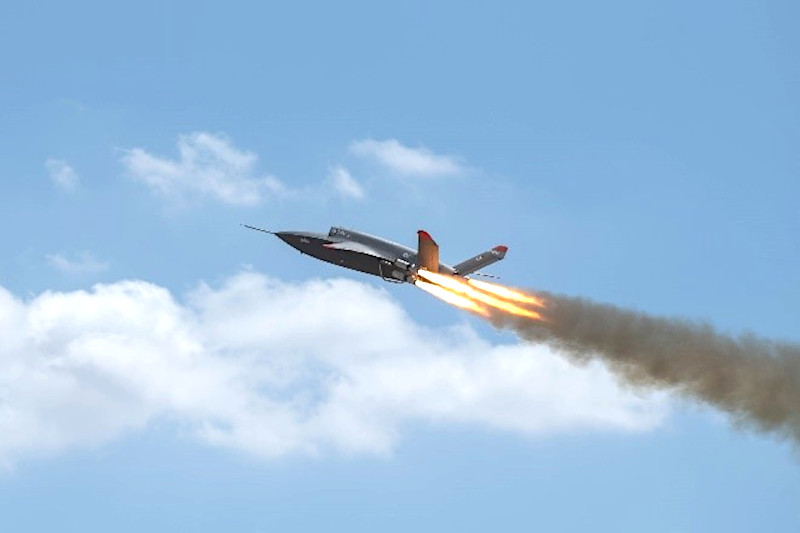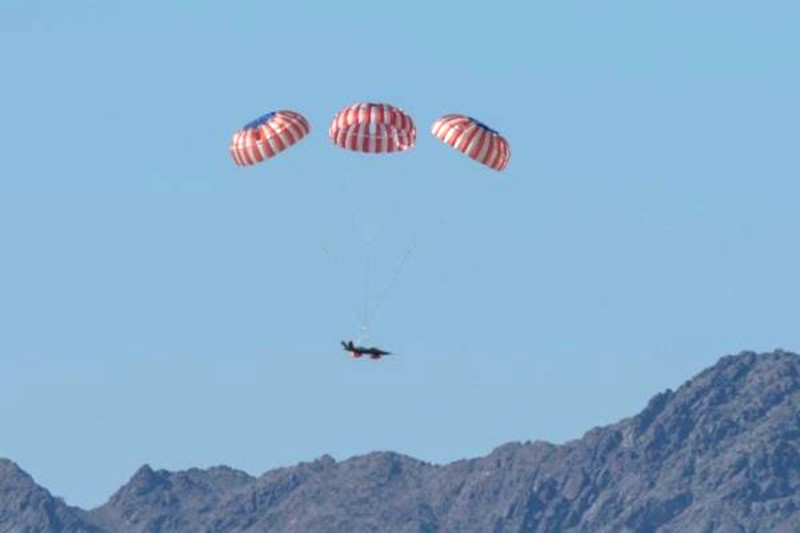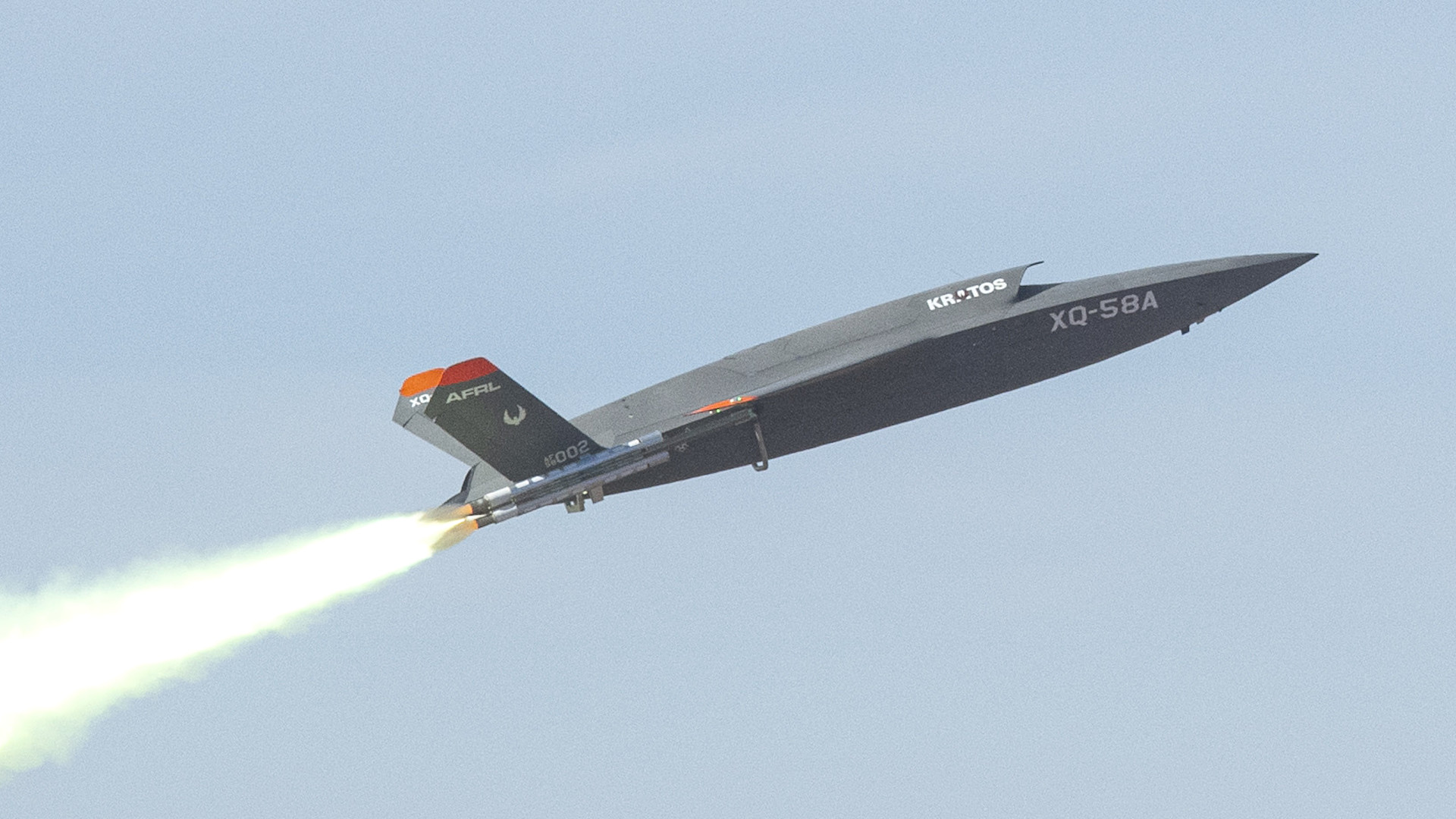Drone maker Kratos says it has successfully shown that its stealthy XQ-58A Valkyrie drone can fly longer, at higher altitudes, and with a heavier overall weight than has ever been demonstrated before, in a recent test flight. This news comes as the company says it is expecting to receive contract awards from two new customers for multiple Valkyries, and that it is also in talks with another client about a potential sale of these drones.
Kratos announced the XQ-58A developments in a press release and a quarterly earnings call yesterday. To date, the U.S. Air Force is the only known entity to have purchased Valkyries, and has been using a growing fleet of these drones to support various research and development and test and evolution efforts. The most well known of these is Skyborg, Air Force Research Laboratory (AFRL) and Air Force Life Cycle Management Center (AFLCMC) led project centered on the development of an artificial intelligence (AI) driven “computer brain” and other associated technologies that could be integrated into various types of drones with high degrees of autonomy.

The press release from Kratos does not say specifically when the recent envelope-expanding test flight occurred, but says that it took place at the U.S. Army’s expansive Yuma Proving Ground (YPG) in Arizona. A new Block 2 XQ-58A from a lot of 12 new-production airframes that the company initially began building on its own initiative was used for the test and this was the first time that particular drone had ever flown. The last Valkyrie in the production lot is expected to be finished next year.
The recent flight “proved XQ-58A’s extended capabilities by flying longer, higher, at a heavier mission weight, and at a longer range than the platform has previously been approved for (based on prior government range limitations) and demonstrated,” according to the release. Kratos did not provide any specific details about the duration of the sortie, how high the drone flew, how much total distance it covered, or its weight.
The company’s website says the XQ-58A has a maximum launch weight of 6,000 pounds, can fly at altitudes up to 45,000 feet above sea level, and has a maximum range of approximately 3,000 miles. The Valkyrie utilizes a rocket-assisted takeoff method involving a static launcher on the ground and is recovered at the end of a flight via parachute.
This runway independence offers certain advantages, especially for conducting forward operations closer to designed target areas, but from locations where there may be no runways may be available at all. A caption to a picture in Kratos’ press release yesterday notes that the runway-less launch and recovery methods could also help keep “runways available for manned operations.” The company says that the XQ-58A is intended to be rapidly deployable and to be operated even from austere locations with a relatively low footprint, too. A containerized launch system concept has been shown in the past that could be used to support these kinds of forward deployments.

The XQ-58A is also designed with an eye toward what is now typically called attritability, which is to say a balance of cost and capabilities that allows their use in higher-risk scenarios that might preclude the use of a more costly and complex ‘exquisite’ asset. The War Zone has talked with Kratos in the past in depth about its views on attritability and affordability in uncrewed aircraft design.
The XQ-58A attritable nature has already been demonstrated in a way by the Air Force, which has already sent the first Valkyrie it acquired to its main museum at Wright Patterson Air Force Base in Ohio. The service said it had made this decision after extensive use of the drone because it never intended to receive “extensive upgrades or repairs.”
In addition, “the flight was conducted with and demonstrated encrypted communications with redundant radios/communications (‘comms’) packages for range and operational missions remote from government ranges. For the final test point, the aircraft navigated to the landing site in a simulated loss of communications scenario,” the press release explained. “It landed within the target zone, demonstrating key autonomous capability for the end of mission phase of flight and recovery of the aircraft without RF [radiofrequency] comms. This capability will help mitigate the possibility of enemy detection and tracking of RF comms emissions as the system returns to ‘base’.”
As Kratos notes here, the XQ-58A’s ability to operate autonomously in a ‘radio silent’ mode has potential benefits when it comes to penetrating through or at least evading threats. It of course also enables the drone to continue its mission or at least attempt to safely return to base in an environment where the threat of electronic warfare jamming is high, something at the U.S. military, among others, expects to be the case in virtually any future high-end conflict. A swarm of such drones would have the additional benefit of being able to operate a distributed ‘mesh’ data-sharing network to provide additional resiliency against electronic warfare attacks and to cooperatively act as a team.
Kratos’ press release also noted that this particular test flight was in support of an AFRL effort called Autonomous Collaborative Enabling Technologies (ACET), which “is focused on developing Autonomous Collaborative Platforms (ACP) such as Collaborative Combat Aircraft (CCA).” CCA is part of the Air Force’s over-arching Next Generation Air Dominance (NGAD) future air combat initiative, and is expected to revolve around multiple tiers of uncrewed platforms with high degrees of autonomy intended to work together on various levels with crewed aircraft to perform a host of different missions, as you can read more about here. NGAD also includes work to develop a stealthy crewed sixth-generation combat jet, as well as advanced sensors, weapons, engines, networking and battle management systems, and more, all of which will form a new air combat ‘ecosystem’ whole.
“While I appreciate the digital simulations and modeling we read about regularly, I am convinced that, much like how our target system aircraft support military training and weapons development with actual flights and shots, Kratos’ regular and envelope-pushing development flights and mission preparation flights are what will ultimately deter our enemies and enhance the readiness of our military,” Eric DeMarco, President and CEO of Kratos Defense & Security Solutions, said in a statement.
The video below shows the XQ-58A’s first flight in 2019, which also took place at the Yuma Proving Ground.

“The Kratos/AFRL team is pushing the envelope in these truly uncharted waters, continuing to evolve the capability and drive affordability in the CCA class where mission capability and effectiveness is achieved through a combination of individual and distributed CCA capability plus mass of aircraft,” Steve Fendley, President of Kratos Unmanned Systems Division, said in a statement related to the recent test flight. “Wargames and analyses consistently report that mass is the solution to enable winning in today’s conflict arena and that a lower count of exquisite systems consistently fails. Kratos is laser-focused on the disruptive, affordable (enabled by simple and elegant) solution set.”
The War Zone has previously reported in detail how wargames that the U.S. military, and think tanks working under contract with it, have conducted have repeatedly shown that networked swarms of relatively low-cost drones with significant levels of autonomy could be a particular game-changer in a conflict with China over Taiwan.

The U.S. military is not the only one increasingly coming around to the view that multiple tiers of uncrewed systems, including ones capable of operating as part of networked autonomous swarms, will be key assets in future high-end aerial combat. This is in turn reflected by Kratos’ disclosures yesterday about expected new and potential future customers.
“We now expect two new Valkyrie-related tactical drone system contract awards from two separate new customers from multiple aircraft,” the company’s President and CEO DeMarco said during an earnings call yesterday. “And we have just recently begun discussions with a potential fourth new customer, also from multiple Valkyrie systems.”
DeMarco declined to say who any of these future or potential customers might be, and it is possible that one or more could simply be other elements of the U.S. military outside of the Air Force. The process of securing U.S. government approval for the sale of more advanced uncrewed aircraft to foreign countries has long been notoriously arduous, though American authorities have sought to reduce at least some barriers to more significant military drone exports in recent years.
Kratos had notably announced in 2018 that its UTAP-22, or Mako, an earlier loyal wingman design, had been cleared for export by American authorities. The company has extensive experience selling various aerial target drones, used for training and various other purposes, to foreign customers including military forces in the United Kingdom, Sweden, South Korea, and Taiwan.

At the same time, a number of major U.S. allies could easily meet more stringent export control requirements and have publicly stated interests in future uncrewed capabilities that something like the XQ-58A might be able to provide. For instance, just on October 31, the U.K. Ministry of Defense announced a new follow-on effort to the Lightweight Affordable Novel Combat Aircraft (LANCA) program, called Low-Cost Uncrewed Air Systems. In June, Britain’s Royal Air Force (RAF) had very publicly canceled a projected called Mosquito, which was part of the larger LANCA effort, and was focused on the development of a loyal wingman-type drone. The RAF did say at the time that it was already expecting to follow up that work with a new project.
Whatever the case, the Valkyrie’s performance envelope and capabilities look to be expanding, and new customers appear to be taking notice.
Contact the author: joe@thedrive.com
